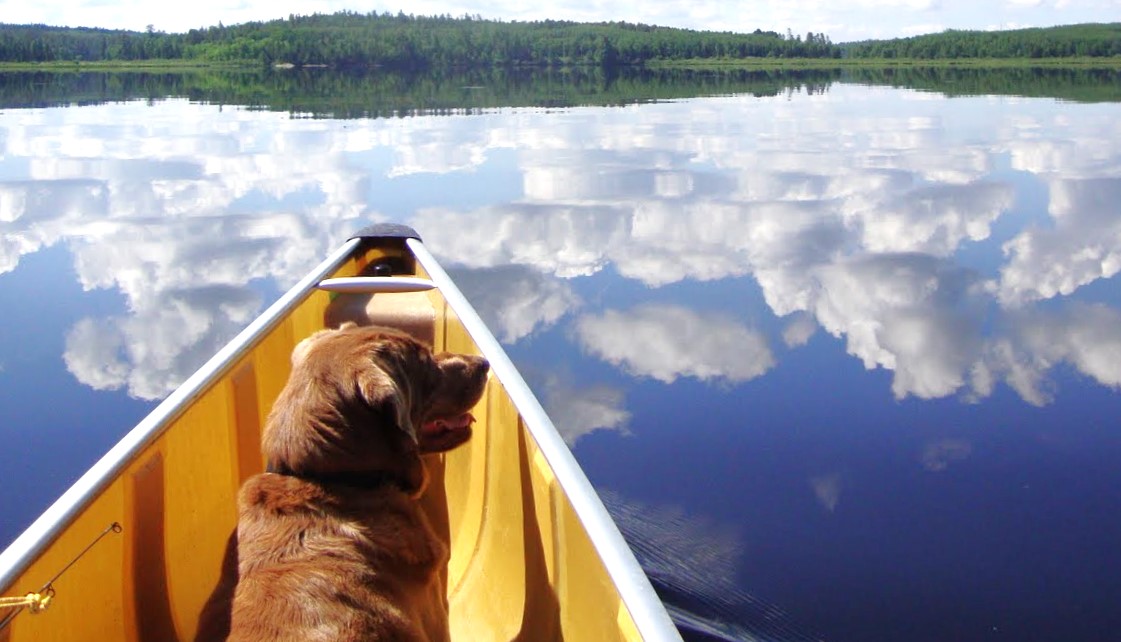
Exploring the Boundary Waters with your best four-legged friend can be a wonderful experience! Or, it can be stressful and unpleasant for you – and your pup. Here’s info and advice on best practices for canine canoe camping success.
Are dogs allowed in the BWCAW?
Yes! No special permit is necessary for a dog to enter the Boundary Waters.
What are the rules regarding dogs in the BWCAW?
The USFS sets the rules for the BWCAW, and these are the USFS rules:
- Dogs must be on a 6-foot leash or shorter at all times.
- Barking must be kept to an absolute minimum to comply with Leave No Trace noise pollution rules.
- Dog waste should be disposed of at least 200 ft away from water sources, portages and campsites, or in campsite latrines.
How do I prepare to bring my dog on a Boundary Waters canoe trip?
- Take your dog for a thorough test paddle (or paddles) before your trip to determine how they do in a canoe. Some dogs react unexpectedly to this new environment, especially as you paddle away from shore or if you get in wind-generated waves.
- Consider training your dog to sit in the bow between the front paddler’s legs. The bow of a canoe allows the dog a comfortable “lead” position and avoids rocking the boat because the dog is in the narrower part of the canoe. It also allows greater control of the dog by the front paddler. Some dogs may fit better in the middle of the canoe next to a pack or in a compartment by themselves. You do not want a squirmy dog that doesn’t follow commands well in the middle of the canoe because their movement could cause a capsize, especially if they are a larger dog.
- Your dog should have a mastery of the commands to sit, lie down and stay – and follow these commands even if in a canoe. Using treats to reinforce all of these skills in the canoe can be very helpful.
- A well-fitted life jacket for your dog is recommended. Spend time getting your dog accustomed to their life jacket well before the trip. A life jacket with a handle on it makes pulling your dog out of the water much easier.
- Train your dog for proper behavior around tents and tarps. Whether you intend to let your dog sleep in the tent with you or have them sleep outside, you need to teach them in advance to not paw at delicate tent and tarp materials. A tent with a hole means mosquitoes will find their way in! It is also important to appreciate that dogs may need to sleep in a tent to escape biting insects. Tent vestibules do not provide insect protection for dogs. Also, if allowing your dog in your tent, keep in mind they may get wet from swimming or the weather and will need dried off.
- Pack dog food in waterproof containers and keep in mind that bears, red squirrels, mice and other animals will be attracted to it. At camp, store the dog food with human food out of reach of bears and other critters.
- Pack a food dish, water dish (if your dog isn’t accustomed to drinking from the lake) and a small trowel for managing dog waste.
- Confirm your dog’s collar is comfortably snug and that ID tags are still accurate and legible.
- Make sure your dog has flea and tick prevention, and have a plan to ensure your dog is protected from mosquitoes and biting flies.
- Dogs will not have shade in the canoe. Some light colored breeds get sunburned. Plan accordingly. They do make sun shirts for dogs.
- Ensure you have a way to keep your dog warm in cold conditions.
- Leave the dog backpack at home. Dog backpacks are uncommon on a Boundary Waters canoe trip because the portages are relatively short and the dog might go for a swim with the pack, which can be messy.
What are best practices for traveling with a dog in the Boundary Waters?
- Always keep tabs on your dog to ensure they don’t run off and get lost. They may encounter new smells: deer, moose, wolves, bears, oh my! Lost dogs are more common in the Boundary Waters than you may think.
- Leashes can be a tripping hazard on portages, so use caution.
- Be aware that it is unlikely but possible that your pup could get tangled up with a skunk or porcupine. If your dog has a run-in with a porcupine, the recommended best practice is to cut your trip short and immediately bring your dog to a vet who can professionally remove the quills.
- Be aware that it is unlikely but possible that predatory wolves, startled moose, birds of prey, or nesting birds could harm your dog.
Need pet-friendly lodging before or after your Boundary Waters trip?
Ely Outfitting Company bunkhouses are dog friendly.
Need a local kennel to board your pet while on trail?
County Line Kennel (218-365-4551) near Ely boards pets. Advance reservations are important.
Does Ely have a veterinary clinic?
Yes. They’re awesome. Ely Veterinary Clinic (218-365-5911), 318 Miners Dr., Ely.
